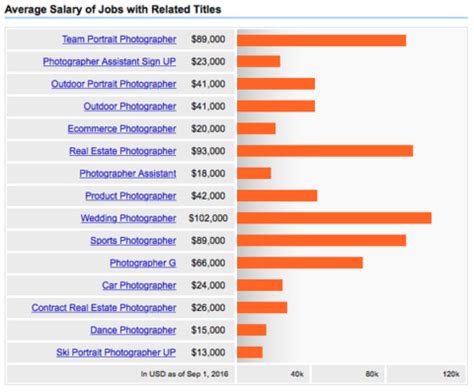Are you passionate about capturing moments through your lens? Do you dream of turning your love for photography into a lucrative career? If so, understanding the ins and outs of photographer salaries is essential for your success. In this blog post, we will delve into the various factors that influence a photographer’s income, from experience and educational background to the rise of freelancing and geographic variations. We will also explore the impact of specialization on photography earnings and uncover the top-paying fields in the industry. Additionally, we will discuss practical strategies for negotiating rates, building a solid client base, and leveraging social media to boost your photography income. Whether you’re a budding photographer looking to turn your passion into a profession or an established professional seeking to maximize your revenue, this post will provide valuable insights to help you achieve your financial goals in the competitive world of photography.
Table of Contents
Understanding the Basics: What is a Photographer’s Salary?
Photography is a popular and versatile profession, but many people are curious about the potential income they could earn as a photographer. Understanding the basic factors that influence a photographer’s salary can provide valuable insight into this field.
One of the main factors influencing a photographer’s salary is their level of experience. Photographers with several years of experience typically command higher rates than those who are just starting out in the industry. This is because experienced photographers have honed their craft and built a strong portfolio, making them more valuable to clients.
Another important factor is the photographer’s location. In major cities and urban areas, there is often a higher demand for professional photographers, leading to higher salaries. Additionally, photographers working in affluent areas or for high-end clientele may also earn higher incomes compared to those in more rural or less affluent areas.
Furthermore, the type of photography specialization can impact a photographer’s earning potential. For example, fashion and portrait photographers may earn more than product photographers due to the high demand and competitive nature of the fashion industry. It’s important for photographers to consider their niche and how it aligns with their income goals.
Factors Influencing Photographer Salaries: From Experience to Location
When it comes to determining a photographer’s salary, there are several factors that come into play, with experience and location being two of the most significant influences.
The more years a photographer has been in the industry, the higher their earning potential tends to be. Experienced photographers often have a larger client base, a strong portfolio, and a reputation that allows them to command higher rates for their services. On the other hand, entry-level photographers may have to start with lower rates while they build up their experience and clientele.
Location also plays a crucial role in determining a photographer’s salary. In metropolitan areas and major cities, where there is higher demand for photography services, photographers may be able to charge higher rates for their work. Additionally, cost of living variations can impact how much a photographer needs to earn to maintain a certain standard of living. This can result in significant salary differences for photographers working in different locations.
Ultimately, the combination of experience and location can greatly impact a photographer’s earning potential, making it important for photographers to consider these factors when determining their rates and seeking job opportunities.
Educational Background and Training: Impact on Photography Earnings
When it comes to photography earnings, the impact of educational background and training cannot be overstated. Many aspiring photographers wonder whether formal education in the field is necessary, and how it might affect their potential income. The truth is that the level of education and training a photographer has can play a significant role in their earning potential.
Photography programs, workshops, and similar educational opportunities can provide photographers with the technical skills, artistic knowledge, and business acumen needed to thrive in the industry. Higher education in the form of a degree in photography, fine arts, or a related field can also provide a strong foundation for building a successful career.
Photographers who invest in their education and training are often better equipped to produce high-quality work, attract a wider range of clients, and command higher fees for their services. Additionally, ongoing education and training can help photographers stay current with industry trends, new technologies, and changing client preferences, all of which can impact their earning potential.
Ultimately, a strong educational background and training can give photographers a competitive edge and contribute to a more lucrative career in the field.
The Rise of Freelancing: Pros and Cons for Photographer Income
In today’s digital age, the rise of freelancing in the photography industry has become increasingly prevalent. With the advent of social media, online marketplaces, and digital marketing, photographers now have the option to work as independent contractors rather than being tied down to traditional employment.
One of the key advantages of freelancing for photographers is the flexibility it offers. Freelancers have the autonomy to choose their own working hours and projects, allowing them to pursue their creative passions on their own terms. Additionally, freelancers have the potential to earn more than those in traditional employment, as they have the freedom to set their own rates and take on multiple projects simultaneously, thereby diversifying their income streams.
On the other hand, freelancing also presents certain challenges for photographers. The inconsistent nature of freelance work means that income can be unpredictable, with some months yielding high earnings while others may bring in little to no income. In addition, freelancers are responsible for managing their own marketing, client acquisition, and administrative tasks, which can be time-consuming and stressful.
Despite the potential drawbacks, the rise of freelancing in the photography industry presents opportunities for photographers to carve out their own niche, build a diverse portfolio, and ultimately increase their income potential. By carefully weighing the pros and cons, photographers can determine whether freelancing is the right path for maximizing their earning potential.
Specialization Matters: How Different Types of Photography Affect Salaries
When it comes to the world of photography, it’s important to understand that not all specializations are created equal in terms of potential earnings. The type of photography you choose to specialize in can have a significant impact on your overall salary potential. Some types of photography are in higher demand than others, and as a result, they often command higher rates.
Wedding photography, for example, is a highly profitable niche, as couples are willing to invest significantly in capturing their special day. On the other hand, portrait photography may not be as lucrative, as it typically requires more frequent shoots and a lower price point.
Another factor to consider is the level of skill and expertise required for different types of photography. Commercial and advertising photography, for instance, often calls for a high level of technical proficiency and creativity, which can lead to higher rates compared to more straightforward types of photography.
Ultimately, the specialization you choose can greatly impact your earning potential as a photographer. It’s important to carefully consider the demand, competition, and required skill level for different types of photography before deciding on your specialization.
Top-Paying Photography Fields: Exploring Lucrative Opportunities
When considering a career in photography, it’s important to understand the diverse range of opportunities available in the industry. While many photographers start with a general focus, such as portrait or wedding photography, there are several niche fields that offer higher earning potential.
One of the top-paying photography fields is commercial photography, which involves creating images for advertisements, catalogs, and marketing materials. Commercial photographers often work with large corporations and advertising agencies, and their expertise is highly valued in the industry. Another lucrative area is fashion photography, where skilled professionals can command high fees for their work with top brands and magazines.
Photojournalism is also a high-paying field, particularly for those who work with major publications and media outlets. This type of photography requires a unique blend of technical skill and storytelling ability, and experienced photojournalists can earn substantial incomes. Additionally, architectural and interior photography are sought-after specialties that cater to the real estate and design industries, providing photographers with excellent earning potential.
Overall, by exploring these top-paying photography fields, aspiring photographers can gain insight into the diverse opportunities available and identify the niche that aligns with their skills and interests, ultimately maximizing their earning potential in the industry.
Geographic Variations: Photography Income Discrepancies Worldwide
Photography income can vary greatly around the world, and there are several factors that contribute to these differences. One of the primary influencers of photography income is the location in which a photographer is based. In countries with a high cost of living, such as the United States and much of Europe, photography rates tend to be higher to accommodate for the higher expenses that photographers incur. Conversely, in countries with a lower cost of living, such as India or Thailand, photography rates are typically lower due to the decreased expenses for photographers.
Another significant factor that contributes to photography income discrepancies worldwide is the demand for professional photography services. In densely populated urban areas, there is often a higher demand for photographers to capture events, portraits, and commercial work, leading to higher average photography earnings. In rural or less populated areas, however, the demand for professional photography services may be lower, resulting in lower average photography incomes.
Additionally, the level of competition in a specific geographic area can impact photography income. In highly competitive locations, such as major cities or popular tourist destinations, photographers may face greater competition from other professionals, potentially driving down photography rates. Conversely, in less competitive areas, photographers may be able to command higher rates due to lower levels of competition.
It is important for photographers to be aware of these geographic variations in photography income in order to make informed decisions about their business practices and pricing strategies. By understanding how location, demand, and competition can impact photography earnings, photographers can better position themselves to maximize their income potential regardless of their geographical location.
Negotiating Rates and Contracts: Maximizing Your Photography Revenue
When it comes to building a successful photography business, negotiating rates and contracts is a crucial skill that can make or break your earnings. The ability to effectively negotiate with clients can have a significant impact on your photography revenue, allowing you to secure higher-paying jobs and establish long-term partnerships.
One key strategy for maximizing your photography revenue through negotiations is to clearly define your value as a photographer. This includes showcasing your portfolio, highlighting your unique skills and expertise, and demonstrating the benefits of working with you. By effectively communicating your value to clients, you can command higher rates and secure contracts that align with your financial goals.
Another important aspect of negotiating rates and contracts is understanding the market and industry standards. Researching typical photography rates in your area and within your specific niche can provide valuable insight into what you should be charging for your services. Additionally, staying informed about current trends and developments in the photography industry can help you position yourself as a competitive and high-value photographer.
It’s also essential to be flexible and adaptable when negotiating rates and contracts. Understanding the specific needs and budget constraints of each client can allow you to tailor your pricing and contract terms accordingly, making it more likely to reach mutually beneficial agreements. By being open to compromise and collaboration, you can build strong relationships with clients and secure a steady stream of income for your photography business.
Building a Solid Client Base: Strategies for Increasing Photographer Earnings
One of the most important factors in increasing a photographer’s earnings is building a solid client base. By establishing long-term relationships with clients, photographers can ensure a consistent stream of work and income. This involves providing exceptional customer service, delivering high-quality photographs, and going above and beyond to meet the client’s needs.
Using social media platforms can also be an effective strategy for building a solid client base. By showcasing their work on platforms such as Instagram, Facebook, and Pinterest, photographers can attract potential clients and expand their reach. Engaging with followers, sharing behind-the-scenes content, and posting testimonials from satisfied clients can help build trust and credibility.
Networking and word-of-mouth referrals are another valuable way to build a solid client base. Attending industry events, participating in photo exhibitions, and collaborating with other professionals can help photographers connect with potential clients and gain exposure. Satisfied clients are also likely to recommend a photographer to their network, leading to new opportunities.
Lastly, offering special promotions and incentives to existing clients can help maintain loyalty and attract new clients. This can include discounted packages for repeat customers, referral discounts, or freebies for clients who book multiple sessions. By showing appreciation for their clients, photographers can foster long-term relationships and increase their earnings.
Leveraging Social Media: Using Online Platforms to Boost Photography Income
When it comes to making a living as a photographer, it’s not just about taking great photos. In today’s digital age, leveraging social media platforms is crucial in boosting your photography income. With the right strategies and consistent effort, photographers can use online platforms to showcase their work, connect with potential clients, and ultimately increase their earning potential.
One of the most effective ways to leverage social media for boosting photography income is by creating a strong and visually appealing online portfolio. Platforms like Instagram, Behance, and Pinterest offer photographers the opportunity to showcase their work to a wide audience and attract potential clients. By curating a portfolio that highlights your unique style and expertise, you can set yourself apart in a competitive market and attract high-paying clients.
In addition to showcasing your work, social media also provides photographers with the opportunity to connect and engage with their audience. By regularly posting high-quality content and engaging with followers through likes, comments, and messages, photographers can build a loyal following that can translate into potential clients and referral opportunities. Building a strong social media presence not only increases your visibility but also positions you as an expert in your field, which can lead to higher-paying opportunities.
Furthermore, leveraging social media for photography income involves strategic marketing and networking. Utilizing platforms like Facebook and LinkedIn allows photographers to join photography groups, connect with industry professionals, and participate in networking events. By actively engaging with the photography community and building relationships with potential clients and collaborators, photographers can increase their earning potential through referrals and partnerships.





